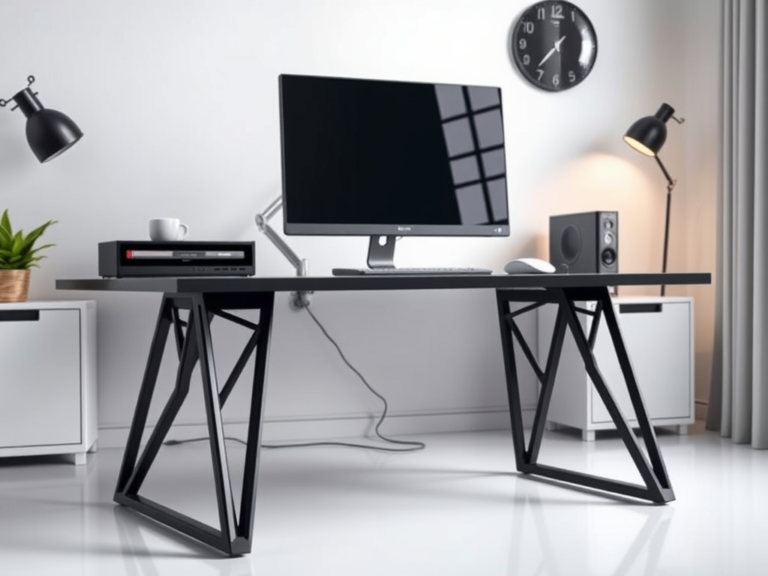
Introduction
In this comprehensive guide, we’ll explore how to design, print, and optimise custom monitor stand legs to enhance your workspace. Whether you’re looking to improve posture, create a minimalist setup, or accommodate multiple monitors, this article will provide all the essential information. A 3d-printed custom monitor riser stand legs can enhance ergonomics, improve desk organisation, and add a personal touch to your workstation. Instead of purchasing expensive, generic monitor risers, 3D printing allows for a fully customisable, cost-effective, and efficient solution.

Why Use 3d-Printed Custom Monitor Stand Legs?
1. Ergonomic Benefits
- Raises the monitor to eye level, reducing neck strain and poor posture.
- Helps maintain a comfortable and healthy viewing angle.
2. Custom Fit for Your Desk Setup
- Adjustable height and width based on individual monitor sizes and desk space.
- Can be designed to support single or multiple monitors.
3. Cost-effective and Eco-Friendly
- 3D printing costs less than buying a commercial monitor riser.
- Reduces plastic waste by printing only what’s needed.
4. Aesthetic and Functional Design
- Choose custom shapes, patterns, and colors to match your desk setup.
- Add features like cable management channels, USB hubs, or storage compartments.
Best Materials for 3D Printing Monitor Stand Legs.
Choosing the right filament is critical for ensuring the durability and stability of the monitor riser.
1. PLA (Polylactic Acid) – Best for Beginners
Easy to print, smooth finish, and widely available. Not highly durable; can warp under heavy weight.
2. PETG (Polyethene Terephthalate Glycol) – Strong and Flexible
More durable than PLA, impact-resistant, and slightly flexible. Requires higher print temperatures; an enclosure may be needed for optimal results.
3. ABS (Acrylonitrile Butadiene Styrene) – Strong and Heat-Resistant
Durable, heat-resistant, and suitable for heavy monitors. Prone to warping; best used in an enclosed printer.
4. Nylon – Maximum Strength
Excellent tensile strength; resistant to wear and tear. Requires precise temperature control and moisture-free storage.
Designing Custom 3d-Printed Monitor Stand Legs
1. Determine the Right Height
- The ideal monitor height aligns the top of the screen with eye level.
- Typical height range: 4-6 inches off the desk.
2. Base and Weight Distribution
- Thicker, reinforced legs prevent instability.
- Consider wider feet or additional crossbars for better weight distribution.
3. Modular and Adjustable Options
- Stackable or interlocking leg designs allow for adjustable height.
- Threaded inserts can create a screw-based adjustable mechanism.
4. Added Features for Functionality
- Cable management holes to keep wires organised.
- Storage compartments under the riser for accessories.
- Ventilation slots to prevent heat buildup from monitors or laptops.
3D Printing Settings for Monitor Stand Legs
1. Layer Height & Print Resolution
- 0.2mm for balanced strength and speed.
- 0.1mm for finer details (if aesthetics are a priority).
2. Infill Density
- 20-30% for lightweight monitors.
- 50-80% for heavy monitors or dual setups.
3. Wall Thickness and Shells
- At least 3-4 outer walls for enhanced strength.
- Increase the top and bottom layers for stability.
4. Print Speed and Cooling
- Print Speed: 40-60mm/s for high precision.
- Cooling: Essential for PLA, but minimal for ABS and PETG.
5. Adhesion and Warping Prevention
- Use a heated bed (50-100°C, depending on the material).
- Apply a brim or raft to reduce warping.
Common Issues and Troubleshooting
1. Warping and Print Lifting Off the Bed
Solution: Use a heated bed and adhesion aids, such as a glue stick, PEI sheet, or painter’s tape.
2. Weak Structural Integrity
Solution: Increase wall thickness and infill percentage. Use PETG or ABS for durability instead of PLA.
3. Layer Separation in ABS or Nylon
Solution: Print in an enclosed chamber for better layer bonding.
4. Printing Takes Too Long
Solution: Use 0.2mm layer height and 20-30% infill for a faster print without sacrificing strength.
Where to Find 3D Models for Monitor Stand Legs
If you don’t want to design from scratch, check out these platforms for ready-to-print monitor stand-leg designs:
- Thingiverse – Free community-driven designs.
- MyMiniFactory – Verified high-quality models.
- Cults3d – Paid and free premium designs.
- CGTrader – Professional 3D models for customisation.
For custom designs, use Fusion 360, Tinkercad, or Blender to modify and optimise your print.
READ MORE – Stylish 3d-Printed CD Wall Holders: The Ultimate Guide to Organising Your Music
FAQs:
1. How much weight can 3d-printed monitor legs support?
With 50% infill and PETG/ABS filament, 3d-printed legs can support up to 15-20 lbs. Increase infill and wall thickness for heavier loads.
2. Can I make adjustable monitor stand legs with 3d printing?
Yes! You can design stackable, modular, or threaded legs for height adjustments.
3. What’s the best filament for strong and durable monitor stand legs?
PETG and ABS are the best choices for stability, durability, and impact resistance.
4. Do I need a special 3d printer for printing large monitor stand legs?
Most standard FDM 3d printers (e.g., Ender 3, Prusa, Anycubic) can handle small to medium-sized monitor stand legs. For oversized legs, use a large-format printer.
5. How do I prevent my monitor from wobbling on 3d-printed stand legs?
Ensure: ✔️ Wider base design ✔️ Strong infill (50-80%) ✔️ Proper weight distribution ✔️ Secure attachment to the monitor platform
Conclusion
Anyone trying to improve ergonomics, organisation, and appearance in their workplace will find a 3D printed custom monitor raise stand leg game-changer. Custom designs, robust materials, and ideal print settings will help you create a monitor riser that is both aesthetically pleasing and useful.
Whether your level of use is casual or professional, 3d printing your
stand legs is a reasonably priced, adaptable substitute for mass-produced solutions. Start your DIY adventure right now and create the ideal monitor stand for your desk!